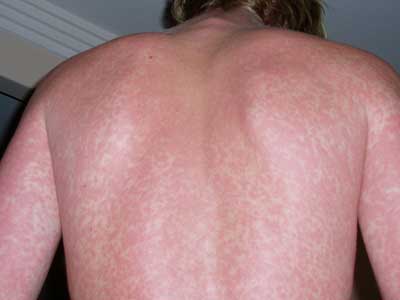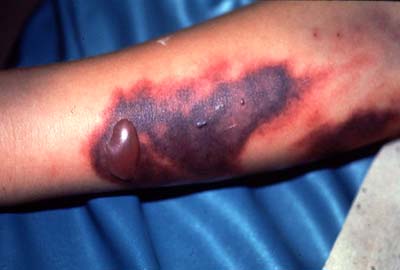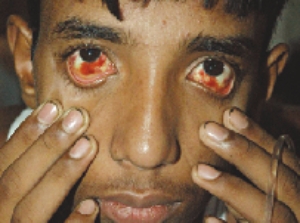With more than one-third of the world’s population living in areas at risk for transmission, dengue infection is a leading cause of illness and death in the tropics and subtropics. As many as 100 million people are infected yearly. Dengue is caused by any one of four related viruses transmitted by mosquitoes. There are not yet any vaccines to prevent infection with dengue virus (DENV) and the most effective protective measures are those that avoid mosquito bites. When infected, early recognition and prompt supportive treatment can substantially lower the risk of developing severe disease. It is a disease that is prevalent in southeast Asia, particularly Thailand and Malaysia.
Dengue has emerged as a worldwide problem only since the 1950s. Although dengue rarely occurs in the continental United States, it is endemic in Puerto Rico, and in many popular tourist destinations in Latin America and Southeast Asia; periodic outbreaks occur in Samoa and Guam.
The following are quotes from some medical studies which should better clarify your understanding of Dengue.
Case history: A 45-year-old woman presents to the emergency department with bleeding gums and bruises on both forearms for the last 2 days. For the preceding 10 days she had been experiencing a high fever (which has since broken) and rigors. In addition, she complains of a rash over both forearms, but she is unable to further characterize it. She noted severe pain in both legs during the febrile portion of her illness. There was no history of hematuria, melena, cough, or hemoptysis. She is not taking any routine prescription medications or using over-the-counter products or supplements. She has no known drug allergies. She is married with 5 children and is currently unemployed. She does not smoke or drink alcohol and has no history of drug abuse. There is no travel history or any history of sick contacts. She is a resident of Pakistan.
On physical examination, she is alert and apparently well developed and well nourished. The patient has a regular pulse of 90 bpm and a respiratory rate of 14 breaths/min. Her temperature is 98.2° F (36.8° C) and blood pressure is 110/70 mm Hg. The cardiac examination reveals a normal S1 and S2, with no murmur, gallop, or rub. Auscultation of the lungs is normal, and no palpable organomegaly or tenderness is found on abdominal examination. Examination of the extremities reveals large bruises and a petechial rash across both forearms and lower extremities. Conjunctival hemorrhages are noted bilaterally. Bruises are also apparent on her soft palate, and minor trauma from oral examination results in gingival hemorrhage.

This patient was diagnosed with dengue hemorrhagic fever (DHF), which is a complication of dengue fever (DF). The diagnosis was eventually confirmed by paired immunoglobulin M samples demonstrating an acute rise in antibodies.
Pathology and Incidence: Dengue hemorrhagic fever is characterized by a fever that lasts from 2 to 7 days, with general signs and symptoms consistent with dengue fever. When the fever declines, symptoms including persistent vomiting, severe abdominal pain, and difficulty breathing, may develop. This marks the beginning of a 24- to 48-hour period when the smallest blood vessels (capillaries) become excessively permeable (“leaky”), allowing the fluid component to escape from the blood vessels into the peritoneum (causing ascites) and pleural cavity (leading to pleural effusions). This may lead to failure of the circulatory system and shock, followed by death, if circulatory failure is not corrected. In addition, the patient with DHF has a low platelet count and hemorrhagic manifestations, tendency to bruise easily or other types of skin hemorrhages, bleeding nose or gums, and possibly internal bleeding.
Dengue virus belongs to the family Flaviviridae (genus Flavivirus) and has emerged as the most common arboviral disease in the world. The disease is endemic to tropical and subtropical areas of the world, with about 2.5 billion people (40% of the world's population) at risk of acquiring the infection. Dengue virus is transmitted to humans through the bites of infective female Aedes mosquitoes (particularly A aegypti and A albopictus). Mosquitoes generally acquire the virus while feeding on the blood of an infected person. After an incubation period of 8-10 days, an infected mosquito is capable, during probing and blood feeding, of transmitting the virus to susceptible individuals for the rest of its life. Unlike malaria, which is more prevalent in rural areas, DF is spread via mosquitoes that thrive in highly populated urban environments.
Four distinct, but closely related, viruses (termed dengue virus types 1-4 [DENV 1-4]) cause DF. Humans are the main amplifying host of the virus. Infection with 1 of the 4 serotypes of dengue virus causes a wide spectrum of clinical disease, including asymptomatic infection, undifferentiated fever, DF, and DHF. DHF occurs in a minority of patients and is characterized by bleeding and plasma leakage, which may lead to shock. The major risk factor for DHF is prior immunity to a single dengue virus serotype. Infection with one dengue serotype confers lifelong homotypic immunity and a very brief period of partial heterotypic immunity (~6 months), but an individual can eventually be infected by more than one serotype. An individual could therefore experience a case of DENV-1 fever in one year, followed by a case of DENV-2 fever in the following year. Third infections are, however, very rare, and fourth infections have never been reported.[6] Several serotypes can be in circulation during a particular epidemic.
Some people infected with DF are asymptomatic. Young children often have a fever with a rash, but other symptoms are minor. Older children and adults may also have mild symptoms; however, they are more likely to experience classic DF. Symptoms of DF include a high fever (up to 105° F [40.5° C]), severe headache, retro-orbital pain, severe muscle and joint pain, swollen lymph nodes, general malaise, nausea, and vomiting; a macular erythematous rash with petechiae may also be observed.[7] The differential diagnosis for DF and DHF is broad and includes meningococcal meningitis, septicemia and disseminated intravascular coagulation, other hemorrhagic fevers (Crimean Congo hemorrhagic fever, Ebola, etc.), thrombotic thrombocytopenic purpura, falciparum malaria, leptospirosis, aplastic anemia, acute leukemia, and yellow fever.

Direct person-to-person transmission of dengue virus has not been documented. A few case reports have been published of transmission of DENV through exposure to dengue-infected blood, organs, or other tissues from blood transfusions; solid organ or bone marrow transplants; needle stick injuries; and mucous membrane contact with dengue-infected blood.
Dengue is transmitted between people by the mosquitoes Aedes aegypti and Aedes albopictus, which are found throughout the world. Insects that transmit disease are vectors. Symptoms of infection usually begin 4 - 7 days after the mosquito bite and typically last 3 - 10 days. In order for transmission to occur the mosquito must feed on a person during a 5- day period when large amounts of virus are in the blood; this period usually begins a little before the person become symptomatic. Some people never have significant symptoms but can still infect mosquitoes. After entering the mosquito in the blood meal, the virus will require an additional 8-12 days incubation before it can then be transmitted to another human. The mosquito remains infected for the remainder of its life, which might be days or a few weeks.
Outbreaks of dengue occur primarily in areas where Ae. aegypti (sometimes also Ae. albopictus) mosquitoes live. This includes most tropical urban areas of the world. Dengue viruses may be introduced into areas by travelers who become infected while visiting other areas of the tropics where dengue commonly exists.

In rare cases dengue can be transmitted inorgan transplants or blood transfusions from infected donors, and there is evidence of transmission from an infected pregnant mother to her fetus. But in the vast majority of infections, a mosquito bite is responsible.
In many parts of the tropics and subtropics, dengue is endemic, that is, it occurs every year, usually during a season when Aedes mosquito populations are high, often when rainfall is optimal for breeding. These areas are, however, additionally at periodic risk for epidemic dengue, when large numbers of people become infected during a short period. Dengue epidemics require a coincidence of large numbers of vector mosquitoes, large numbers of people with no immunity to one of the four virus types (DENV 1, DENV 2, DENV 3, DENV 4), and the opportunity for contact between the two. Although Aedes are common in the southern U. S., dengue is endemic in northern Mexico, and the U.S. population has no immunity, the lack of dengue transmission in the continental U.S. is primarily because contact between people and the vectors is too infrequent to sustain transmission.
Dengue or dengue-like epidemics were reported throughout the nineteenth and early twentieth centuries in America, Southern Europe, North Africa, the east Mediterranean, Asia, Australia, and on various islands in the Indian Ocean, the south and Central Pacific, and the Caribbean. DHF has increased both in incidence and distribution over the past 40 years, and, in 1996, 2.5-3.0 billion people lived in areas potentially at risk for dengue virus transmission. It is estimated that there are 20 million cases of dengue infection annually, resulting in around 24,000 deaths. The geographic distribution of dengue viruses and their mosquito vectors has expanded, and DHF has emerged in the Pacific region and the Americas. In Southeast Asia, epidemic DHF first appeared in the 1950s, but by 1975 it had become a leading cause of hospitalization and death among children in many countries in that region.[ In Europe, the last dengue epidemic dates from 1927-1928 in Greece, with high mortality. However, there continues to be imported cases of DF in travelers returning to Europe from endemic areas.
In the 1980s, DHF began a second expansion into Asia when Sri Lanka, India, and the Maldives Islands had their first major DHF epidemics; Pakistan first reported an epidemic of DF in 1994. The recent epidemics in Sri Lanka and India were associated with multiple dengue virus serotypes. After an absence of 35 years, epidemic DF occurred in both Taiwan and the People's Republic of China in the 1980s. The People's Republic of China had a series of epidemics caused by all 4 serotypes, and its first major epidemic of DHF, caused by DENV-2, was reported on Hainan Island in 1985. Singapore also had a resurgence of DF/DHF from 1990 to 1994 after a successful control program had prevented significant transmission for over 20 years. In other countries in Asia where DHF is endemic, the epidemics have become progressively larger in the last 15 years.
A recent outbreak of DF in Karachi occurred in 2005 when Aga Khan University reported 30 positive cases out of 100. A recent trend of DF in southeastern countries is that it has become endemic, causing cyclical epidemics every 2-3 years.
A major challenge for public health officials in all tropical areas of the world is the development and implementation of sustainable prevention and control programs that will reverse the trend of emergent DHF.[13] Environmental controls, including solid waste management, decreasing vector breeding sites by eliminating standing water, improvement in public awareness by media, and the use of household insecticides and mosquito repellants can help prevent the spread of dengue virus. Active case surveillance is important for early detection and implementation of control programs in the setting of acute epidemics. Unfortunately, there is no commercially available vaccine to prevent dengue. Tetravalent vaccines are currently being studied.
Clinically, the diagnosis of DF is suggested by the presence of fever, severe headache, maculopapular skin rash, and myalgias associated with either the isolation or identification of DENV from either serum, plasma, or tissue specimens, or by demonstration of a 4-fold increase of DENV antibodies in paired serum samples. The diagnosis of DHF is based on similar clinical features associated with a bleeding diathesis and/or thrombocytopenia. In some patients, a shock syndrome (dengue shock syndrome) may be observed.
The principal symptoms of dengue fever are high fever, severe headache, severe pain behind the eyes, joint pain, muscle and bone pain, rash, and mild bleeding (e.g., nose or gums bleed, easy bruising). Generally, younger children and those with their first dengue infection have a milder illness than older children and adults.
Dengue hemorrhagic fever (DHF) is characterized by a fever that lasts from 2 to 7 days, with general signs and symptoms consistent with dengue fever. When the fever declines, warning signs may develop. This marks the beginning of a 24 to 48 hour period when the smallest blood vessels (capillaries) become excessively permeable (“leaky”), allowing the fluid component to escape from the blood vessels into the peritoneum (causing ascites) and pleural cavity (leading to pleural effusions). This may lead to failure of the circulatory system and shock, and possibly death without prompt, appropriate treatment. In addition, the patient with DHF has a low platelet count and hemorrhagic manifestations, tendency to bruise easily or have other types of skin hemorrhages, bleeding nose or gums, and possibly internal bleeding.
Aedes aegypti, the principal mosquito vector of dengue viruses is an insect closely associated with humans and their dwellings. People not only provide the mosquitoes with blood meals but also water-holding containers in and around the home needed to complete their development. The mosquito lays her eggs on the sides of containers with water and eggs hatch into larvae after a rain or flooding. A larva changes into a pupa in about a week and into a mosquito in two days. See Aedes main aquatic habitats; from tree cavities to toilets and learn about the mosquitoes life cycle. People also furnish shelter as Ae. aegypti preferentially rests in darker cool areas, such as closets leading to their ability to bite indoors.
It is very difficult to control or eliminate Ae. aegypti mosquitoes because they have adaptations to the environment that make them highly resilient, or with the ability to rapidly bounce back to initial numbers after disturbances resulting from natural phenomena (e.g., droughts) or human interventions (e.g., control measures). One such adaptation is the ability of the eggs to withstand desiccation (drying) and to survive without water for several months on the inner walls of containers. For example, if we were to eliminate all larvae, pupae, and adult Ae. aegypti at once from a site, its population could recover two weeks later as a result of egg hatching following rainfall or the addition of water to containers harboring eggs.
It is likely that Ae.aegypti is continually responding or adapting to environmental change. For example, it was recently found that Ae. aegypti is able to undergo immature development in broken or open septic tanks in Puerto Rico, resulting in the production of hundreds or housands of Ae.aegypti adults per day. In general, it is expected that control interventions will change the spatial and temporal dispersal of Ae. aegypti and perhaps the pattern of habitat utilization. For these reasons, entomological studies should be included to give support before and throughout vector control operations.
The treatment of DF and DHF is essentially supportive. Antipyretics as well as fluid resuscitation, monitoring, and support are often necessary. Monitoring of laboratory parameters and replenishment with blood products as necessary are indicated in severe cases of DHF. The World Health Organization has created a useful guide (Dengue Haemorrhagic Fever: Diagnosis, Treatment, Prevention and Control; available at the WHO Website) that delineates recommended approaches to the identification and management of DHF patients.
There is no vaccine for preventing dengue. The best preventive measure for residents living in areas infested with Ae. aegypti is to eliminate the places where the mosquito lays her eggs, primarily artificial containers that hold water.
Items that collect rainwater or to store water (for example, plastic containers, 55-gallon drums, buckets, or used automobile tires) should be covered or properly discarded. Pet and animal watering containers and vases with fresh flowers should be emptied and cleaned (to remove eggs) at least once a week. This will eliminate the mosquito eggs and larvae and reduce the number of mosquitoes present in these areas.
Using air conditioning or window and door screens reduces the risk of mosquitoes coming indoors. Proper application of mosquito repellents containing 20% to 30% DEET as the active ingredient on exposed skin and clothing decreases the risk of being bitten by mosquitoes. The risk of dengue infection for international travelers appears to be small. There is increased risk if an epidemic is in progress or visitors are in housing without air conditioning or screened windows and doors.
The best way to reduce mosquitoes is to eliminate the places where the mosquito lays her eggs, like artificial containers that hold water in and around the home. Outdoors, clean water containers like pet and animal watering containers, flower planter dishes or cover water storage barrels. Look for standing water indoors such as in vases with fresh flowers and clean at least once a week.
The adult mosquitoes like to bite inside as well as around homes, during the day and at night when the lights are on. To protect yourself, use repellent on your skin while indoors or out. When possible, wear long sleeves and pants for additional protection. Also, make sure window and door screens are secure and without holes. If available, use air-conditioning.
If someone in your house is ill with dengue, take extra precautions to prevent mosquitoes from biting the patient and going on to bite others in the household. Sleep under a mosquito bed net, eliminate mosquitoes you find indoors and wear repellent
The patient presented in this case was admitted to an inpatient medical ward for 10 days and managed with intravenous fluids as well as repeated platelet and packed red blood cell transfusions. She was discharged when her platelet count reached 60 × 103/µL (60 × 109/L). She returned to the outpatient department after 3 weeks for follow-up, at which time her bleeding, rash, and other symptoms had improved.
MEDSCAPE and other journals
